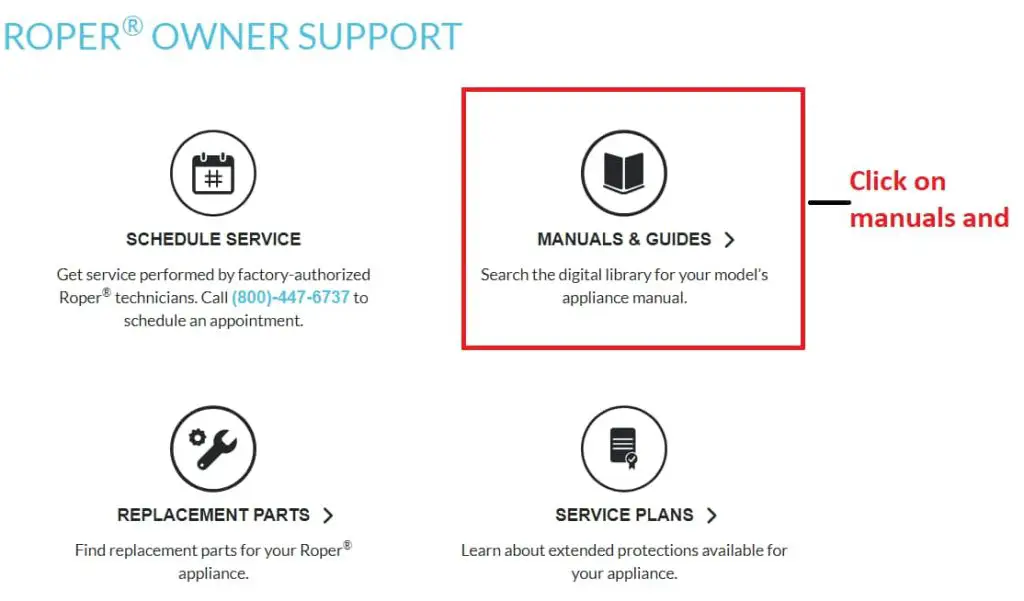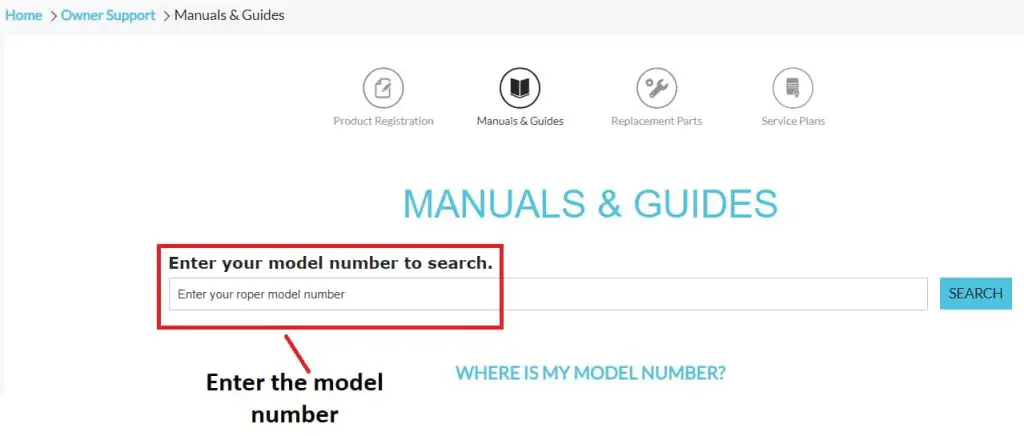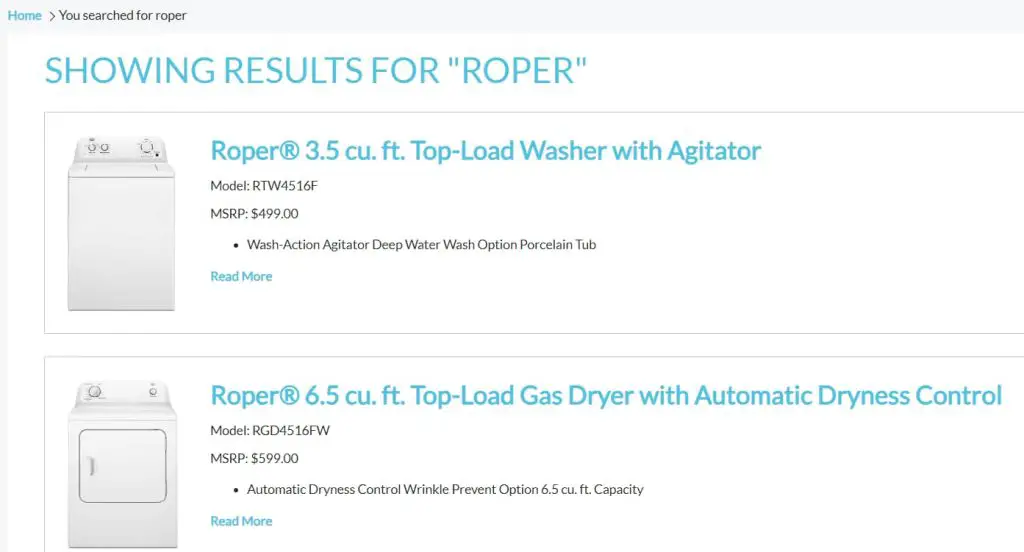Roper washing machines are known for their durability and reliability, offering a cost-effective solution for your laundry needs.
However, like any other appliance, they are not immune to issues and minor hiccups.
Having knowledge about troubleshooting basic Washing machine issues is crucial for the long-term health of your machine.
Understanding how to identify and fix common washing machine problems can save you time, and money, and extend the lifespan of your appliance.
In this blog post, we will look into some common issues that you may face in a roper washing machine along with possible troubleshooting steps
Table of Contents
Brand Overview
Is Roper a division of Whirlpool?
Yes. In 1989, Whirlpool Corporation acquired the Roper brand, making it a part of their extensive line of home appliances. This acquisition has allowed Roper to benefit from Whirlpool’s technological advancements and quality assurance.
How long does a Roper washing machine typically last?
When it comes to longevity, a Roper washing machine typically lasts between 10 to 15 years, depending on usage and maintenance. This durability is a testament to the brand’s commitment to quality and reliability.
Common Issues and How to Troubleshoot Them
The roper washing machine not turning on
If your Roper washing machine is not turning on, the first step in washing machine troubleshooting is to check the power supply.
Ensure that the machine is properly plugged in and that the circuit breaker or fuse box hasn’t tripped.
If everything seems fine but the machine still won’t turn on, it could be an issue with the motor or control panel, and you may need professional washing machine repair.
Roper washing machine not filling
A Roper washing machine not filling with water is a common issue that can often be resolved easily.
Start by checking the water supply hose to ensure it is not kinked or blocked.
Next, inspect the inlet valve and filters for any clogs.
If these washing machine parts are in good condition but the problem persists, it could be a faulty water level sensor or control board, requiring further diagnosis and potentially professional repair.
Roper washing machine not spinning
If your Roper washing machine is not spinning, there are several factors to consider.
First, check the lid switch with a multimeter; if it lacks continuity, it’s likely faulty and needs replacement.
A broken drive belt can also prevent the drum from spinning; inspect it for any signs of wear or breakage.
Also, a defective motor coupling or suspension rods can also halt the spin cycle.
If none of these washing machine parts is the issue, it could be a problem with the control board or other components like the door latch, drive motor, drive pulley, or drum bearing.
The only logical approach here is to replace any defective parts, such as the lid switch or drive belt, to restore your machine’s spinning function.
Roper washing machine not agitating
If your Roper washing machine is not agitating, start by checking the power supply.
An unlatched lid or problematic lid switch can also prevent the machine from agitating; ensure it’s closed and test the lid switch’s continuity with a multimeter.
Inspect the agitator repair kit, drive block, drive belt, motor coupling, and control board for wear and tear.
So, if any of these components are defective, they will need to be replaced.
If the issue is not with these parts, consider replacing the control board.
Roper washing machine not rinsing
If your Roper washing machine is not rinsing, several factors could be at play.
First, check the water inlet valve to ensure it’s not clogged or malfunctioning.
A faulty valve can prevent water from entering the drum for the rinse cycle.
Next, inspect the water supply hose to make sure it’s not kinked or blocked.
Another common issue is a defective timer or control board, which can disrupt the rinse cycle.
Lastly, a malfunctioning motor or belt can also prevent the machine from moving to the rinse cycle.
So take the logical approach by clearing any clogs in the water inlet valve or supply hose, and consider replacing them if they are damaged.
If the timer, control board, motor, or belt is faulty, these washing machine parts will need to be replaced.
Roper washing machine stopping mid-cycle
This issue could be due to an overheating motor, which automatically shuts down to prevent damage.
It could also be a result of a faulty lid switch, which interrupts the cycle if it thinks the lid is open.
Another possibility is a malfunctioning water level sensor, which can incorrectly signal that the drum is full or empty, causing the machine to stop.
Electrical issues, such as a tripped circuit breaker or fuse box, can also halt the cycle.
The best way to approach such type of issue is to allow the motor to cool down if overheating is suspected and then restart the machine.
Next, check the lid switch for continuity and replace it if necessary.
If the water level sensor is faulty, it will need to be replaced and for electrical issues, reset the circuit breaker or replace the fuse.
Roper washing machine stuck on sensing fill
If your Roper washing machine is stuck on the sensing fill cycle, it could be due to a few different issues.
One common culprit is the water level sensor, which may be malfunctioning and causing the machine to be stuck in this mode.
Another possibility is a faulty control board that is unable to move the cycle forward.
To resolve this issue, first, try resetting your Roper washing machine by unplugging it for a few minutes and then plugging it back in.
If the problem persists, you may need to replace the water level sensor or the control board.
Roper washing machine leaking from the bottom
A Roper washing machine leaking from the bottom is a serious issue that needs immediate attention.
The leak could be coming from a loose or damaged water supply hose, a cracked tub, or a faulty drain pump.
It’s also possible that the machine is overfilled, causing water to leak out.
To get around this, first, check the water supply hose and tighten any loose connections.
If the hose is damaged, replace it.
Inspect the tub for cracks and the drain pump for any signs of damage.
If the machine is overfilled, adjust the water level settings and restart the cycle.
Also Read: Calibrating Roper Washing Machine (Comprehensive Guide)
Tips for Preventing Common Washing Machine Problems
Here are some tips to help you avoid common problems with Roper washing machines:
Regular Inspection
Periodically check washing machine parts like hoses, belts, and filters for wear and tear. Replace them as needed to prevent issues like leaks and malfunctions.
Proper Loading
Overloading your Roper washing machine can cause undue stress on the motor and belts, leading to premature wear.
Always adhere to the manufacturer’s guidelines for load size.
Use the Right Detergent
Using the wrong type of detergent can lead to residue buildup, affecting the machine’s performance.
Always use the correct detergent type and the dosage.
Clean the Lint Trap
A clogged lint trap can lead to problems like poor drainage and even fires. Establish a routine for routinely cleaning the lint trap.
Check Water Supply
Ensure that the water supply hose is not kinked or blocked, as this can affect the machine’s ability to fill and rinse.
Run Empty Cycles
Periodically run an empty cycle with a washing machine cleaner to remove any detergent or mineral buildup.
Check Electrical Connections
Make sure the machine is properly plugged in and that the circuit breaker is not tripped. A stable power supply is crucial for the machine’s operation.
Read the Manual
The Roper washing machine manual often contains valuable tips and error codes for troubleshooting. Familiarize yourself with it to better understand your machine.
Diagnostic Mode and Resets
How to enter diagnostic mode on a Roper washing machine?
Entering Diagnostic Mode:
- Initial State: Make sure the washer is shut off and all indicator lights are off.
- Control Dial Rotation: Turn the control dial one complete rotation (360 degrees) counterclockwise.
- Quick Actions: Quickly within about six seconds, turn the control dial three clicks clockwise, one click back, and one more click clockwise.
- Confirmation: All the green status lights will blink when you successfully activate the diagnostic mode.
Note: If the status lights don’t blink, turn the control dial one complete rotation counterclockwise to reset the control and try again, this time turning the knob faster.
Displaying Error Codes
- Control Dial: Turn the control dial one-click clockwise.
- Start Button: Press the start button.
- First Error Code: Turn the control dial one-click clockwise to display the first saved error code. The control can display up to four error codes and if no error code is recorded, just the sensing light will flash.
Understanding Error Codes
Error codes for VMW washers have two parts:
- The first is the letter “F” followed by a number.
- The second letter “E” is followed by a number in the second case.
- Indicator Lights for Numbers:
- Sensing light ON indicates the letter “F”.
- Sensing light OFF indicates “E”.
- Wash light stands for the number 8.
- Rinse light stands for the number 4.
- Spin light stands for the number 2.
- Cycle complete light stands for the number 1.
Exiting Diagnostic Mode
- To exit the diagnostic mode, simply turn the washer off.
Roper washing machine diagnostic mode not working
If you find that the diagnostic mode on your Roper washing machine is not working, there could be several reasons for this.
First, ensure that the washing machine is plugged in and turned on.
Also, check the circuit breaker or fuse box to confirm that there is power to the machine.
You can try resetting the washing machine by unplugging it for 30 seconds and then plugging it back in.
If you still can’t access the diagnostic mode post following the above steps, the issue could be a faulty control panel, problems with the wiring, or a malfunctioning motor.
It is best to contact a professional appliance repair technician.
Roper washing machine diagnostic mode flashing
If the diagnostic mode light on your Roper washing machine is flashing, it could indicate a variety of issues, and the specific problem may vary depending on the model and the pattern of the blinking lights.
Here are some common causes:
- Water Level Sensor Problem: The water level sensor is crucial for detecting the water level in the washer. A malfunctioning sensor can cause the washer to either not fill at all or overfill, leading to a blinking diagnostic mode light.
- Water Inlet Valve Problem: This valve is responsible for supplying water to the washer. If it’s not functioning correctly, the washer may not fill, causing the diagnostic mode light to blink.
- Control Board Problem: The control board acts as the washer’s computer. If it’s not working properly, it may fail to detect issues with the water level sensor or water inlet valve, also causing the diagnostic mode light to blink.
So, if you encounter a blinking diagnostic mode light, the first step is to reset the washer.
Unplug it from the power outlet for 30 seconds and then plug it back in.
If the light continues to blink post-reset, it’s advisable to contact a qualified appliance repair technician for diagnosis and repair.
When to Call a Professional?
While washing machine troubleshooting can resolve many common issues, there are situations where professional intervention is necessary.
Here are some signs that you should call a technician:
- Persistent Error Codes: If Roper washing machine error codes keep appearing even after you’ve followed the troubleshooting steps in the manual, it’s time to seek professional help.
- Electrical Issues: Problems like frequent circuit breaker trips or visible wiring damage are best handled by a qualified technician to ensure safety.
- Water Leaks: If you’ve checked all the usual suspects like hoses and seals but your Roper washing machine is still leaking, you may have a more serious issue that requires professional attention.
- Unusual Noises: Persistent strange noises like grinding or banging are often signs of internal issues that require a technician’s expertise.
- Failure to Start or Complete Cycles: If your machine won’t start at all or stops mid-cycle and you’ve ruled out simple issues like power supply or lid latch, it’s time to call a professional.
How to Find a Qualified Technician?
- Referrals: Word of mouth is often the most reliable way to find a good service technician. Ask friends or family for recommendations.
- Online Reviews: Websites and forums that provide reviews of local appliance repair services can be a valuable resource.
- Certification: Look for technicians who are certified by recognized institutions. This makes sure that they have the knowledge and experience required.
- Warranty: If your Roper washing machine is still under warranty, contact the manufacturer for authorized service centers.
- Estimates: Always get a written estimate before any work begins to avoid unexpected costs.
By recognizing when to call a professional and how to find a qualified one, you can ensure that your Roper washing machine receives the best possible care, extending its lifespan and performance.
Additional Resources
Roper Washing Machine Manual
One of the most valuable resources for understanding and troubleshooting your Roper washing machine is the owner’s manual.
This manual provides detailed information on washing machine maintenance, error codes, and other essential topics.
To get the owner’s manual for your specific Roper washing machine model, you can visit the Roper website at Roper Appliances Owner Support.
Once on the site, click on owner support.

Next, click on manuals on the guide on the next page.

You’ll find a search box where you can enter your model number, as shown in the figure below.

After locating your manual, you can download it for future reference.

By having the manual readily available, you can quickly identify and resolve common problems with Roper washing machines, ensuring that your appliance remains in optimal condition for years to come.
Final Thoughts
Owning a Roper washing machine or any washer comes with the responsibility of regular maintenance and troubleshooting to ensure its longevity and optimal performance.
From understanding common issues like not turning on, not filling, or leaking, to knowing when to call a professional, being proactive can save you both time and money.
The diagnostic mode and error codes serve as essential tools for identifying problems, and the owner’s manual is an invaluable resource for any Roper washing machine owner.
You May Also Like
- What does dE on LG washer Indicate? (Troubleshoot dE error)
- Why is the Whirlpool washer not agitating? (Troubleshooting)
- The Ultimate Guide to troubleshoot Portable Washing Machine Issues
- What is F20 Error on a Whirlpool Washing Machine? (Fixed)
- The Ultimate Guide to Storing Your Portable Washing Machine
- What is the H2O supply error on the GE washer?
- LG washer UE code: How to fix it?
- What is an AC6 error in a Samsung washer? (How to fix it?)





